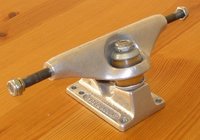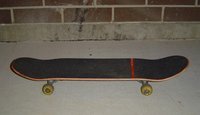Skateboard
A skateboard is a narrow wheeled platform (usually made of plywood), used for recreation and transportation. It was developed in the twentieth century by surfers, who first made them using rollerskates. They are typically part of western youth culture.
The skateboard has evolved a lot since the 50s, not only in shape but also materials used. Boards in the past where often in the shape of a fish, with little concave and had 1 ply of wood. The wheels where rather large compared to most of todays sizes and the trucks (axles) where also larger in size and less sturdy. Another difference is that the boards of the past had a very small nose, todays boards have almost identical noses and tails (the tail is usually a bit steeper however).

Composition -- Parts of the Skateboard
The Deck - Skateboards are composed of several parts. The deck forms the body of the skateboard and provides a place to stand. It is covered with grip tape, which adds friction to its surface. The deck is normally 76-91 cm long (2 1/2 to 3 feet). The longboard, a common variant of the skateboard, has a longer deck. Decks were originally a single piece of wood but are now made from usually seven plys of Canadian Hard Rock Maple glued together, or (more uncommonly) other composite materials.
The width of the deck varies from smaller models like 7.4" to larger ones like 8.25" or 8.38". Larger decks are better suited to vert skaters who need more control and stability while riding down the steep slopes. Thinner decks are suited to street skaters who like to perform more technical tricks; a wider board often makes it akward to pull off such maneuvers.
The Trucks - Attached to the deck are two metal trucks, which connect to the wheels. (The corresponding parts of trains and other vehicles are also called trucks.) The trucks are further composed of two parts. The top part of the truck is screwed to the deck and is called the baseplate, and beneath it is the hanger. Between the baseplate and the hanger are bushings, also rubbers or grommets, that provide the spring mechanism for turning the skateboard. The bushings cushion the truck when it turns. The stiffer the bushings, the more stable the skateboard. The softer the bushings, the easier it is to turn. A bolt called a kingpin holds these parts together.
The Wheels - Two polyurethane wheels attach to each hanger. The wheels come in various sizes and like the deck both suit different types of skating. Larger sizes like 60-65mm roll faster which makes riding vert ramps easier. Smaller sizes like 50-55mm keep the board closer to the ground and are lighter which makes tricks easier to perform. For general cruising you want larger, softer wheels, alternativly, look into longboards and dirtboards.
Bearings - Inside each wheel are two ball bearings. Bearings are measured with the ABEC rating system, which goes from 1-9, in odd numbers. It was designed with machines in mind, not skateboards, so the ABEC rating rates the precision of the bearing. This means that as the rating goes up, the bearing usually gets weaker - since skateboarding puts a lot of pressure on the bearings anyway, they wont last long. It's better to use ABEC 5 bearings, because they are durable but also smooth enough.
Other Parts - There are special products available to help raise the board away from the trucks/off the ground. Risers are placed inbetween the underside of the deck and the truck. This elevates the deck from the ground slightly (which will avoid "wheel-bite"; where the deck makes contact with the wheel, often on a hard turn, causing the board to stop suddenly). Another good reason to use risers is that they help relieve stress from the trucks, meaning less chance of the deck cracking under all that pressure. More risers will equal a higher board which also lowers the "pop" you get when you push down on the tail to perform an ollie (it will require more effort to maintain a higher ollie).
Use
Skateboards are used for skateboarding and skateboarding tricks. A person who rides a skateboard is a skateboarder or a skater. Skateboarders may wear protective clothing, including but not limited to helmets, gloves, knee and elbow pads or wrist braces especially when riding in skateparks (where it may be required by skatepark rules). A substantial amount (in fact, virtually all) of street riders scorn all safety equipment, citing better mobility and lack of need, even though it's a very dangerous sport.

